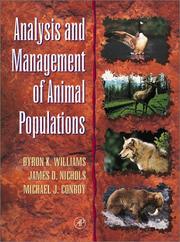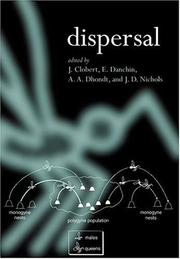| Listing 1 - 10 of 13 | << page >> |
Sort by
|
Book
ISBN: 9811054363 9811054355 Year: 2017 Publisher: Singapore : Springer Singapore : Imprint: Springer,
Abstract | Keywords | Export | Availability | Bookmark
 Loading...
Loading...Choose an application
- Reference Manager
- EndNote
- RefWorks (Direct export to RefWorks)
This book addresses issues of monitoring populations of tigers, ungulate prey species and habitat occupancy, with relevance to similar assessments of large mammal species and general biodiversity. It covers issues of rigorous sampling, modeling, estimation and adaptive management of animal populations using cutting-edge tools, such as camera-traps, genetic identification and Geographic Information Systems (GIS), applied under the modern statistical approach of Bayesian and likelihood-based inference. Of special focus here are animal survey data derived for use under spatial capture-recapture, occupancy, distance sampling, mixture-modeling and connectivity analysees. Because tigers are an icons of global conservation, in last five decades,enormous amounts of commitment and resources have been invested by tiger range countries and the conservation community for saving wild tigers. However, status of the big cat remains precarious. Rigorous monitoring of surviving wild tiger populations continues to be essential for both understanding and recovering wild tigers. However, many tiger monitoring programs lack the necessary rigor to generate the reliable results. While the deployment of technologies, analyses, computing power and human-resource investments in tiger monitoring have greatly progressed in the last couple of decades, a full comprehension of their correct deployment has not kept pace in practice. In this volume, Dr. Ullas Karanth and Dr. James Nichols, world leaders in tiger biology and quantitative ecology, respectively, address this key challenge. The have collaborated with an extraordinary array of 30 scientists with expertise in a range of necessary disciplines - biology and ecology of tigers, prey and habitats; advanced statistical theory and practice; computation and programming; practical field-sampling methods that employ technologies as varied as camera traps, genetic analyses and geographic information systems. The book is a 'tour de force' of cutting-edge methodologies for assessing not just tigers but also other predators and their prey. The 14 chapters here are lucidly presented in a coherent sequence to provide tiger-specific answers to fundamental questions in animal population assessment: why monitor, what to monitor and how to monitor. While highlighting robust methods, the authors also clearly point out those that are in use, but unreliable. The managerial dimension of tiger conservation described here, the task of matching monitoring objectives with skills and resources to integrate tiger conservation under an adaptive framework, also renders this volume useful to wildlife scientists as well as conservationists.
Life sciences. --- Ecology. --- Nature conservation. --- Life Sciences. --- Nature Conservation. --- Predation (Biology) --- Communities, Predator-prey --- Dynamics, Predator-prey --- Interactions, Predator-prey --- Predator-prey communities --- Predator-prey dynamics --- Predator-prey interactions --- Predator-prey relations --- Predator-prey relationships --- Predator-prey systems --- Predators and prey --- Predatory behavior (Biology) --- Predatory-prey relationships --- Prey and predators --- Prey-predator relationships --- Preying (Biology) --- Relations, Predator-prey --- Relationships, Predator-prey --- Systems, Predator-prey --- Animal ecology --- Animals --- Parasitism --- Food --- Conservation of nature --- Nature --- Nature protection --- Protection of nature --- Conservation of natural resources --- Applied ecology --- Conservation biology --- Endangered ecosystems --- Natural areas --- Balance of nature --- Biology --- Bionomics --- Ecological processes --- Ecological science --- Ecological sciences --- Environment --- Environmental biology --- Oecology --- Environmental sciences --- Population biology --- Conservation --- Ecology --- Ecology .
Digital
ISBN: 9789811054365 Year: 2017 Publisher: Singapore Springer Singapore, Imprint: Springer
Abstract | Keywords | Export | Availability | Bookmark
 Loading...
Loading...Choose an application
- Reference Manager
- EndNote
- RefWorks (Direct export to RefWorks)
This book addresses issues of monitoring populations of tigers, ungulate prey species and habitat occupancy, with relevance to similar assessments of large mammal species and general biodiversity. It covers issues of rigorous sampling, modeling, estimation and adaptive management of animal populations using cutting-edge tools, such as camera-traps, genetic identification and Geographic Information Systems (GIS), applied under the modern statistical approach of Bayesian and likelihood-based inference. Of special focus here are animal survey data derived for use under spatial capture-recapture, occupancy, distance sampling, mixture-modeling and connectivity analysees. Because tigers are an icons of global conservation, in last five decades,enormous amounts of commitment and resources have been invested by tiger range countries and the conservation community for saving wild tigers. However, status of the big cat remains precarious. Rigorous monitoring of surviving wild tiger populations continues to be essential for both understanding and recovering wild tigers. However, many tiger monitoring programs lack the necessary rigor to generate the reliable results. While the deployment of technologies, analyses, computing power and human-resource investments in tiger monitoring have greatly progressed in the last couple of decades, a full comprehension of their correct deployment has not kept pace in practice. In this volume, Dr. Ullas Karanth and Dr. James Nichols, world leaders in tiger biology and quantitative ecology, respectively, address this key challenge. The have collaborated with an extraordinary array of 30 scientists with expertise in a range of necessary disciplines - biology and ecology of tigers, prey and habitats; advanced statistical theory and practice; computation and programming; practical field-sampling methods that employ technologies as varied as camera traps, genetic analyses and geographic information systems. The book is a 'tour de force' of cutting-edge methodologies for assessing not just tigers but also other predators and their prey. The 14 chapters here are lucidly presented in a coherent sequence to provide tiger-specific answers to fundamental questions in animal population assessment: why monitor, what to monitor and how to monitor. While highlighting robust methods, the authors also clearly point out those that are in use, but unreliable. The managerial dimension of tiger conservation described here, the task of matching monitoring objectives with skills and resources to integrate tiger conservation under an adaptive framework, also renders this volume useful to wildlife scientists as well as conservationists.
Nature protection --- General ecology and biosociology --- big data --- Bayesian statistics --- ecologie --- natuurbescherming

ISBN: 0127544062 Year: 2002 Publisher: San Diego, CA ; New York, NY ; Boston, MA : Academic Press,
Abstract | Keywords | Export | Availability | Bookmark
 Loading...
Loading...Choose an application
- Reference Manager
- EndNote
- RefWorks (Direct export to RefWorks)
Animal populations --- Wildlife management --- Animaux --- Faune --- Mathematical models --- Estimates --- Statistical methods --- Populations --- Modèles mathématiques --- Estimation --- Méthodes statistiques --- Aménagement --- Modèles mathématiques --- Méthodes statistiques --- Aménagement --- Population Dynamics. --- Population Control --- methods. --- statistics & numerical data.
Book
ISBN: 4431546480 4431994947 9786612994609 1282994603 4431994955 9784431994954 Year: 2011 Publisher: Berlin ; New York : Springer,
Abstract | Keywords | Export | Availability | Bookmark
 Loading...
Loading...Choose an application
- Reference Manager
- EndNote
- RefWorks (Direct export to RefWorks)
Remote photography and infrared sensors are widely used in the sampling of wildlife populations worldwide, especially for cryptic or elusive species. Guiding the practitioner through the entire process of using camera traps, this book is the first to compile state-of-the-art sampling techniques for the purpose of conducting high-quality science or effective management. Chapters on the evaluation of equipment, field sampling designs, and data analysis methods provide a coherent framework for making inferences about the abundance, species richness, and occupancy of sampled animals. The volume introduces new models that will revolutionize use of camera data to estimate population density, such as the newly developed spatial capture–recapture models. It also includes richly detailed case studies of camera trap work on some of the world’s most charismatic, elusive, and endangered wildlife species. Indispensable to wildlife conservationists, ecologists, biologists, and conservation agencies around the world, the text provides a thorough review of the subject as well as a forecast for the use of remote photography in natural resource conservation over the next few decades.
Animal ecology -- Statistical methods. --- Animal populations -- Estimates -- Methodology. --- Photography in wildlife monitoring. --- Wildlife photography. --- Animal ecology --- Photography in wildlife monitoring --- Wildlife research --- Wildlife conservation --- Photography --- Animal populations --- Ecology --- Photography in environmental monitoring --- Zoology --- Earth & Environmental Sciences --- Zoology - General --- Health & Biological Sciences --- Methodology --- Research --- Remote sensing --- Scientific applications --- Monitoring --- Methodology. --- Remote sensing. --- Animals --- Life sciences. --- Zoology. --- Life Sciences. --- Biology --- Natural history --- Biosciences --- Sciences, Life --- Science

ISBN: 0198506597 0198506600 9780198506591 9780198506607 Year: 2001 Publisher: New York : Oxford University Press,
Abstract | Keywords | Export | Availability | Bookmark
 Loading...
Loading...Choose an application
- Reference Manager
- EndNote
- RefWorks (Direct export to RefWorks)
574.91 --- 574.91 Migration. Change of habitat --- Migration. Change of habitat --- Animals --- Animal dispersal --- Dispersal of animals --- Dispersal --- Animal ethology and ecology. Sociobiology --- Animal population --- population genetics --- population structure --- Population distribution --- Dispersal. --- Animaux --- Dispersion --- Animals - Dispersal --- Acqui 2006
Book
Year: 1990 Publisher: Washington (D.C.) : Wildlife society,
Abstract | Keywords | Export | Availability | Bookmark
 Loading...
Loading...Choose an application
- Reference Manager
- EndNote
- RefWorks (Direct export to RefWorks)
Animal ecology --- Animal populations --- Experimental design --- Population dynamics. --- Statistical methods --- Data processing. --- Statistical methods --- Evaluation. --- Evaluation.
Digital
ISBN: 9784431994954 Year: 2011 Publisher: Tokyo Springer Japan
Abstract | Keywords | Export | Availability | Bookmark
 Loading...
Loading...Choose an application
- Reference Manager
- EndNote
- RefWorks (Direct export to RefWorks)
Book
Year: 1990 Publisher: Washington (D.C.): Wildlife society
Abstract | Keywords | Export | Availability | Bookmark
 Loading...
Loading...Choose an application
- Reference Manager
- EndNote
- RefWorks (Direct export to RefWorks)
Book
ISBN: 9784431994954 Year: 2011 Publisher: Tokyo Springer Japan
Abstract | Keywords | Export | Availability | Bookmark
 Loading...
Loading...Choose an application
- Reference Manager
- EndNote
- RefWorks (Direct export to RefWorks)
Remote photography and infrared sensors are widely used in the sampling of wildlife populations worldwide, especially for cryptic or elusive species. Guiding the practitioner through the entire process of using camera traps, this book is the first to compile state-of-the-art sampling techniques for the purpose of conducting high-quality science or effective management. Chapters on the evaluation of equipment, field sampling designs, and data analysis methods provide a coherent framework for making inferences about the abundance, species richness, and occupancy of sampled animals. The volume introduces new models that will revolutionize use of camera data to estimate population density, such as the newly developed spatial capture-recapture models. It also includes richly detailed case studies of camera trap work on some of the world's most charismatic, elusive, and endangered wildlife species. Indispensible to wildlife conservationists, ecologists, biologists, and conservation agencies around the world, the text provides a thorough review of the subject as well as a forecast for the use of remote photography in natural resource conservation over the next few decades.
Book

ISBN: 9789811569340 9789811569357 9789811569364 9789811569333 Year: 2021 Publisher: Singapore Springer Singapore :Imprint: Springer
Abstract | Keywords | Export | Availability | Bookmark
 Loading...
Loading...Choose an application
- Reference Manager
- EndNote
- RefWorks (Direct export to RefWorks)
Nature protection --- General ecology and biosociology --- Animal ethology and ecology. Sociobiology --- ecologie --- natuurbescherming
| Listing 1 - 10 of 13 | << page >> |
Sort by
|

 Search
Search Feedback
Feedback About UniCat
About UniCat  Help
Help News
News